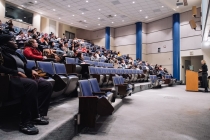Small classes engender more learning in universities
UMBC’s lectures are currently in the province of the professor to decide whether or not the lecture component of the class is mandatory. It should stay this way.
Universities are always trying to optimize the attendance and participation of students in lectures and classes as a method of bringing up the graduation rate and average GPA of the school. One way to do this is to diminish the lecture size. This has all the benefits of discussion based classes without having to resort to team based learning. However, UMBC does not have many of these smaller classes in places they perhaps should.
Smaller classes have the benefit of being more personal and allowing there to be discussion between the students, as well as between student and professor. Part of the problem with large lectures is that students are overwhelmed, both by the impersonality and by the amount of information disseminated without actual hands-on practice. In smaller classes, students feel more comfortable asking questions and clarifying information.
Smaller classes are also easier for professors to teach. They can tailor their class to the students. Students show up for class more often. Students who do show up actually listen, and they are more accountable for schoolwork.
Even though there are not that many small classes here at UMBC, teachers do prefer them. Gib Mason is a certified public accountant and director of the UMBC Training Center, and also teacher of an entrepreneur class at UMBC. “I was delighted the class only had 20 students in it. It is more intimate with fewer students; more so than even a class of around 30 students,” said Mason. He also stated that it engenders an “environment of participation, presentation and teamwork, and there is a high level of engagement in the classroom.”
Many universities are taking the initiative to pick up these benefits by making their larger lectures smaller, including such universities as M.I.T., University of Maryland and Harvard. These universities are making their lectures, physics classes specifically, smaller and more hands on. The benefits are manifold, as the universities have seen a decrease by 50% in their failure rate and an increase in attendance from 50% to 80%.
This is what a university should be aiming for, but this initiative has not yet been adopted by UMBC. Granted, there is often a discussion section, or “discovery” for these large classes, however, discussion sections do not always directly address the information disseminated in the actual class, they are more peripheral.
In addition, the downsides to large lectures are still in place – the drop in attendance, the engagement being limited to a few students in the front row, the low level of retention of the information – and could be remedied by just making the whole class smaller.
At UMBC, the student to teacher ratio is advertised as 20:1, a major selling point for admissions. But this is an ideal ratio – in reality most of the STEM classes are more like 200:1. This is because many of the classes, especially sciences, have larger class sizes due to the necessity of these classes.
So shouldn’t UMBC try to make their small student : teacher ratio an actual fact so students gain more out of the classes?
UMBC does try to gain this discussion quality for the class, with “team based learning” in some of the larger classes. However, this team based learning is not the optimal system, according to many students.
UMBC needs to make many of their lectures smaller to fully optimize the learning potential, and not experience the downsides from large lectures.

